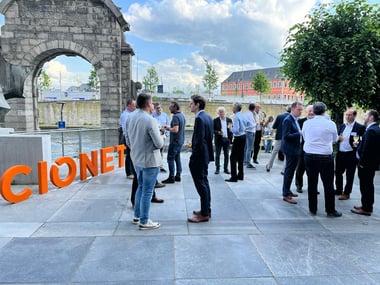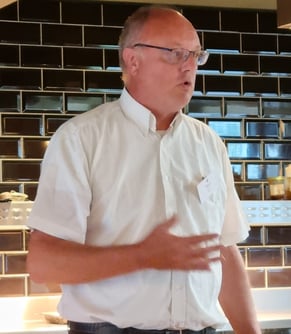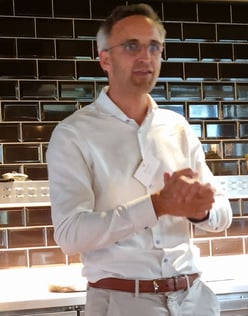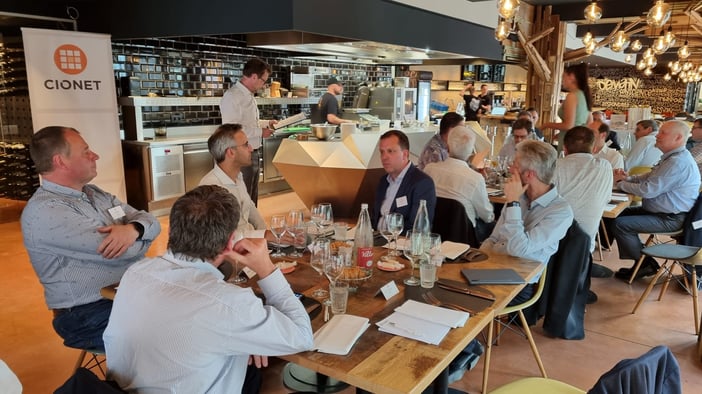Businesses have moved beyond the stage of adopting the cloud primarily to rationalise their IT infrastructure, reduce costs and increase agility. These drivers for cloud adoption are still valid, but they have been leapfrogged by the need to drive business transformation and innovation. And indeed, cloud adoption does enable organisations to become business innovators. This was, without saying, the main conclusion of the second edition of the "Rencontres de CIONET", our programme for the French-speaking digital leaders of this country.
Some thirty IT executives from Wallonia and Brussels came together to reflect on the power of the cloud as a driver of innovation and digital transformation during an executive dinner in "La table de demain", a restaurant at the confluence of the Sambre and Meuse rivers in the heart of Namur. Four top speakers started the discussions: Olivier Luxon, CIO of Carrefour, in duo with his colleague Pascal Van Dooren, Head of Cloud & eWorkplace. Next came Marc Cornil, Group Manager for IT Infrastructure and Cloud at Engie. Followed by Benoit Sepulchre, Head of IT Infrastructure & Cloud, Architecture and Security at Belfius.
French version here
.png?width=780&name=BE20220517%20-%20Cloud%20-%20Les%20rencontres%20de%20cionet%20(1).png)
"Thanks to the cloud, Carrefour has become much more data-driven and able to meet the needs of its collaborators and customers proactively." - Olivier Luxon, CIO Carrefour

Carrefour has chosen to migrate to the (Google) cloud for more than two years now. In the first phase, most attention was evidently paid to a successful "lift and shift". This shift to the cloud has undeniably brought essential optimisations in costs and efficiency compared to the former on-premise infrastructure. Still, the most significant progress has been made in personalisation and access to technology for all collaborators, IT teams, and others. Security is now application and role-based, allowing everyone to access the systems they need via the device of their choice - mobile or otherwise. Support for the 800+ shops across the country accelerated, with much shorter intervention times and higher satisfaction. A dedicated data team was set up that worked in a structured manner on the storage and analysis of the (huge amounts of) data and real-time reporting for the benefit of the business units.
"Within the ENGIE Group, the cloud is a global enabler for standardisation and centralisation and forms the basis for the development of our 'energy-as-a- service' offering." - Marc Cornil,
Sr Advisor Engie

Since 2016, Engie has opted for a Cloud-First approach to serve its "3D" strategy: three Ds that stand for decentralisation, digitalisation and decarbonisation. Decentralisation was initiated with the massive migration of the data centres and group applications to the cloud and the deployment of global cloud applications such as O365 for its employees worldwide. Today more than 200,000 Engie employees work on the same network, with the same workplace, communication and collaboration tools. Decarbonisation and digitalisation went hand in hand to drive savings and optimisation in energy production and consumption and have paved the way for an 'energy-as-a-service' offering. Two elements played a crucial role. Firstly the setting up of a data-centric organisation: the creation of a global data lake containing the data of more than 3,000 data sources, the implementation of the necessary analysis and reporting tools, and the creation of a pool of analytical competencies for the benefit of the group. Secondly comes the digital factory that develops strategic applications at the Group level. Marc Cornil then gave four examples of industrial applications that endorse these objectives: "Darwin", an intelligent real-time application for the operational follow-up of wind farms, hydroelectric plants or biogas plants worldwide, "Smart institutions", an application that allows hospitals, campuses or municipalities to carry out global energy management, covering all energy sources and the entire life cycle, "Robin": the application for the intelligent and proactive management of a power plant. And finally, LIVIN, the application that helps local authorities to fine-tune their infrastructure management and make the citizen’s life better.
"Belfius initial plan to go for a massive migration of its core banking systems to a package strategy in the cloud, progressively shifted towards a cloud strategy that generates immediate business and customer value" - Benoit Sepulchre, Belfius.

Belfius' original plan was to migrate the core banking applications running on the mainframe to a software package in Microsoft's Azure cloud. However, that strategy gradually evolved into of a pragmatic approach and a hybrid infrastructure that combines the best of all worlds, including the mainframe. Today, the bank applies a 'cloud first' strategy: every new service is cloud-based. The priority is to build a digital platform in the cloud that makes the bank's digital services highly accessible and user-friendly. In addition, the bank is developing new cloud-based services such as "Rebel", its investment platform, or "Banx", its 100% digital bank, in collaboration with Proximus. These products could be brought to the market quickly and in complete security (security by design) thanks to their cloud character.
And what are the challenges the bank faces in doing so? In rolling out its cloud strategy (private vs public vs multi-cloud), the bank always guards against excessive concentration of risks. Other challenges remain the management of a hybrid infrastructure while making all platforms seamlessly talk to each other. Next to the data integration between the environments in the cloud and on-premise, including the mainframe. And last but not least, the never-ending battle to attract the right digital talents into the bank.
After their short presentations, the speakers took place at the tables with the guests. Between the menu courses, a small "chair dance" took place, during which the speakers changed tables to offer all guests the opportunity to further exchange experiences and ideas with them. A unique formula that apparently was particularly appreciated by the guests, judging by the intensity of the conversations that unfolded at each table.

Special thanks to our partners of the “Rencontres de CIONET” programme: DELOITTE,
DENODO and NEO4J.
.png)
.png?width=780&name=BE20220517%20-%20Cloud%20-%20Les%20rencontres%20de%20cionet%20(1).png)




No Comments Yet
Let us know what you think